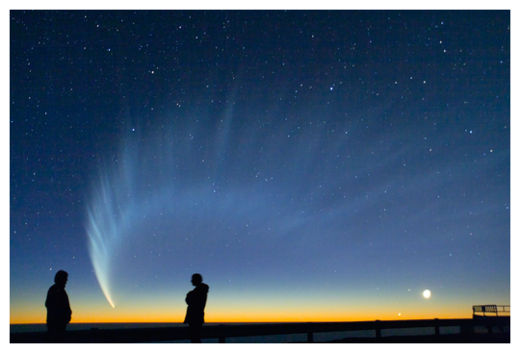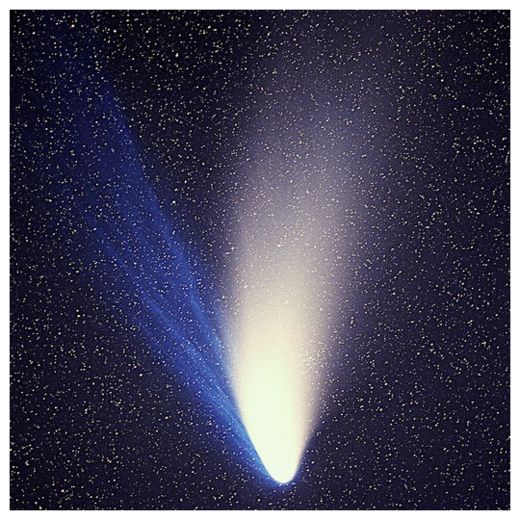
Or so says David Eichler, lead author of a forthcoming Astrophysical Journal Letters paper positing that a sun-grazing comet roughly the size of Hale-Bopp (with a nucleus some 30 kms in diameter), could trigger cosmic ray-generating shockwaves large enough to initiate a global electromagnetic Armageddon.
Eichler, an astrophysicist at Israel's Ben-Gurion University of the Negev in Beer-Sheva, argues that satellites that weren't in protection mode would be wiped out along with most of the world's electronics - everything from micro-circuitry on cell phones to full-scale power stations.
If such a comet were the size of Hale-Bopp, Eichler says, the resulting solar flare would by far be the largest ever observed.
The comet gets compressed and then explodes in the solar atmosphere which, in turn, creates shockwaves, says Eichler.
Eichler thinks that such a sun-grazing comet may have triggered a large solar flare and cosmic ray-generating shockwaves as recently as 775 A.D., as indicated by tree ring analysis pointing to a sudden 1.2 percent spike in atmospheric Carbon 14.
"I'm not saying that [event] couldn't have been caused by a magnetic solar flare, but we've never seen a solar flare nearly that big," said Eichler.
Although the motion of such a sun-grazer would be the source of the shockwaves' energy, the actual particle acceleration would happen within the sun's magnetic field, explains Eichler.
Traveling at a 1000 kms per second, the shockwaves would reach earth in about a day and a half. And the effects would likely be much worse than the 1859 Carrington Event, a solar superstorm that wreaked havoc on telegraph lines and caused the aurora borealis to be visible as far south as Texas.
"From the looks of the tree ring data, fortunately, such events don't happen but once every several thousand years," said Eichler. "But by my estimates such a comet event might be 30 times stronger than the Carrington Event."
Such a sun-grazing event's resulting volley of cosmic rays would be funneled in along earth's magnetic poles where magnetic resistance is the least, Eichler explains.
When the shockwaves hit the earth's magnetic field, it would be like the hammer of a piano hitting a string, says Eichler. It would vibrate. And when a magnetic field line vibrates, he says, it makes an electric field which excites current in wires.
"It can excite the current and burn out the circuit," said Eichler. "That's the danger of giant electromagnetic pulses; these huge electric fields hit tiny micro-circuitry designed to handle only small currents."
Although not expected to be harmful to humans, such an event could be extremely devastating to our electronic grid and could quite possibly send us back into a new Stone Age, says Eichler.
As for predicting future sun-grazers?
Most sun-grazing comets are too small to even make a ripple on the solar surface.
A recent exception was Comet Lovejoy, a long period sun-grazing comet which in December 2011, was observed to unexpectedly survive its closest solar approach.
Eichler says it's quite possible that a very large comet could graze the sun once every several thousand years.
"If the Hale-Bopp-sized comet grazed the solar corona," said Eichler, "then you'd get a much bigger solar flare than the Carrington Event. Hale-Bopp itself may become sun-grazing in the [distant] future."
But there is one positive. Astronomers should, in principle, get a few years notice if such a large potential sun-grazing comet comes around again.
However, with a few classified military exceptions, our electronics remain unprotected against such potential magnetospheric trauma, he says.
Today, the Carrington Event itself would be devastating, says Eichler, and it wasn't particularly powerful or all that unusual on an astrophysical timescale.
After completing his research, Eichler says he is most surprised by the fact that we're still here to tell the tale.
"I didn't realize the solar system was such a dangerous place," said Eichler. "Just the fact that we've gone as long as we have without worse things happening may be why we're here."




if it is in the msm (mainstream media), then someone in officialdom wants it there.
The agenda is to provide wrong explanation of the real electrical process going on around us.
Solar System as 4D energy vortex
[Link]